"Depaving" the Way to Greener Neighborhoods
Air Date: Week of May 9, 2025
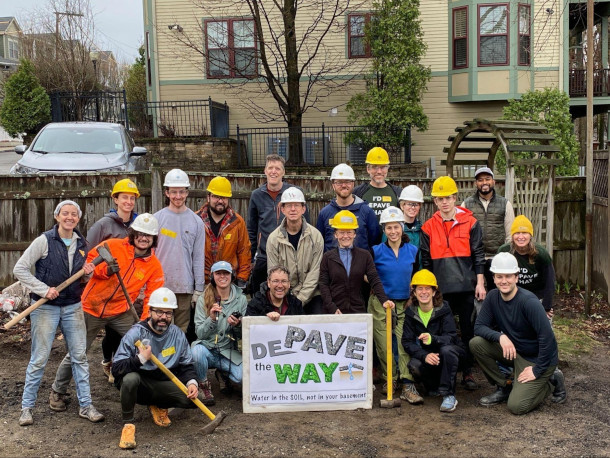
Green and Open Somerville’s “Depave the Way” initiative aims to help neighborhoods adapt to climate change and increase green space. From left: Leigh Meunier (black vest), Eduardo Rodriguez (orange), Jack Briskie (light gray) and Depave the Way participants. (Photo: Green and Open Somerville)
"Depaving parties" of volunteers with sledgehammers are turning paved yards into pollinator havens and green space. That can help reduce climate impacts from extreme heat and flooding. Living on Earth’s Sophia Pandelidis reports from Somerville, Massachusetts.
Transcript
O’NEILL: In the warm weather months, a 90-degree day every so often can be a nice treat. But by 2070, the Massachusetts Bay Area will likely see almost 40 more of these days a year than it currently does. And too much of a good thing can definitely have its drawbacks. In the Boston area, the city of Somerville is particularly vulnerable. Over three quarters of Somerville is paved, and eighty two percent of the city is defined as a “hot spot,” or an area that has a heat index in the top 5% statewide. Stronger storms intensified by climate change are a threat there, too. Just a few decades from now, extreme storms in parts of Somerville could bring up to 10 feet of flooding. But there may be some relief in sight. Somerville residents are taking matters into their own hands. Living on Earth’s Sophia Pandelidis went to find out more.
[sfx dumpster and sledgehammer]
PANDELIDIS: It’s Sunday morning, and a rag tag group of neighbors has shown up to party.
[sfx sledgehammer]
PANDELIDIS: But not the way you might think. First off, they’re all wearing hard hats.
MEUNIER: And please make sure, if you're in this area, that you're wearing your equipment the whole time.
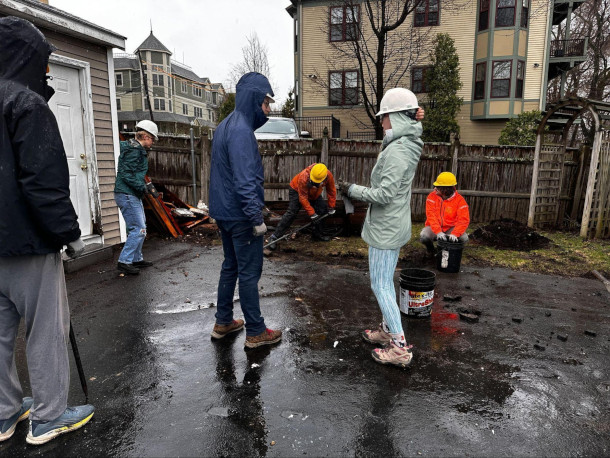
Living on Earth producer Sophia Pandelidis (second from right) gets the run-down of how depaving works. (Photo: Green and Open Somerville)
PANDELIDIS: This is a “depaving party.” About 20 volunteers are gathered in the fully paved backyard of a Somerville, Massachusetts home. And it’s their job to rip it up.
LIPSHULTZ: Swinging.
[sfx sledgehammer]
LIPSHULTZ: Wow, Oh my gosh.
PANDELIDIS: Armed with sledgehammers and wheelbarrows, the group works together to break up the asphalt and carry it to a dumpster in the driveway.
[sfx dumpster]
PANDELIDIS: The goal is to leave this yard pavement free. These “depaving parties” have been happening since 2010 and are now run by Green and Open Somerville. Leigh Meunier is one of the leaders of the group’s “Depave the Way” initiative. Her wide, bright eyes make you want to listen to her. She says there’s more than one reason to ditch asphalt.
MEUNIER: One of the things I really love about depaving is, is that it is multipurpose.
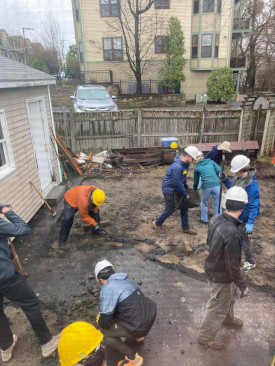
Armed with sledgehammers and wheelbarrows, volunteers work together to break up the asphalt and remove it. (Photo: Green and Open Somerville)
PANDELIDIS: First, it helps neighborhoods adapt to climate change. Depaving can prevent flooding by giving stormwater a place to soak into the ground and lower temperatures by reducing the urban heat island effect. That could save lives, especially in environmental justice communities that face higher heat risks. But climate resilience isn’t the only benefit to depaving.
MEUNIER: Ideally, when you can get pavement out, it increases not just more space for water to go, but it increases opportunities for planting gardens, for planting trees, for yards, for kids to run around and play, park space, etc. It's like, amazing.
PANDELIDIS: Yards filled with native plants instead of asphalt can also be havens for pollinators and local wildlife.
Jack Briskie, the host of today’s depaving, has plans for that.
BRISKIE: I've watched far too much Home Improvement TV on building bee houses, actually.
PANDELIDIS: But Leigh’s favorite part of depaving is how it brings the community together in an active way.
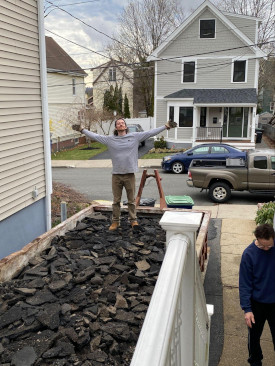
Host Jack Briskie stands in the dumpster full of asphalt. Renting a dumpster can cost up to $700. (Photo: Green and Open Somerville)
MEUNIER: I want to get sweaty. I want, I want my active energy, you know, to go towards something, and my creative energy to go towards something that's meaningful.
PANDELIDIS: One veteran depaver, Eduardo Rodriguez, is on a similar wavelength. He says there’s something cathartic about swinging that sledgehammer.
RODRIGUEZ: That first drop just releases so much rage. Yeah, we have a lot to rage about right now.
PANDELIDIS: The “depaving” movement is not new. It got its start in Portland, Oregon back in 2007, and has since spread across the United States and even Europe. Leigh says word is travelling fast here in Somerville.
MEUNIER: More people are biking, walking, taking transit, and have less need for cars. So we have all these long driveways that fit like five cars, and everybody's moving in and saying, I don't need that anymore, you know.
PANDELIDIS: This season’s depaving schedule is already filling up.
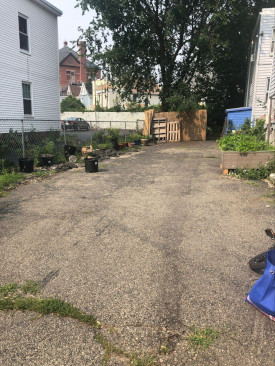
Another Somerville driveway before depaving. (Photo: Green and Open Somerville)
MUENIER: We're now on track to do at least seven this year, if not more.
PANDELIDIS: Everyone who wants to depave should be able to, Leigh says. But keeping up with growing demand is tough for her small team. And while volunteers are free, depaving still has a price too steep for some: up to $700 to rent a dumpster.
[sfx dumpster]
PANDELIDIS: So Green and Open Somerville is partnering with local NGOs to offset those costs for low-income, environmental justice neighborhoods. Leigh dreams of a time when she’ll get to lead these parties every weekend. For now, though, it’s time to sit back and admire the day’s work.
MEUNIER: Depaving, to me is, like, one of those things too, where you can, in three hours, see the fruits of your labor.
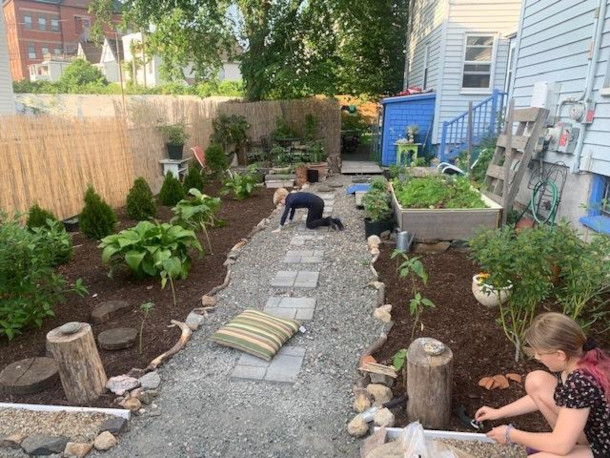
These residents decided to plant a garden where their driveway used to be. (Photo: Green and Open Somerville)
PANDELIDIS: She’s right. At the end of the party, it’s incredibly satisfying to watch as the last chunks of pavement are carried away and we’re left with…well, an actual yard, though it’s barren for now. So the group heads inside, muddy and tired, but proud. Their sandwiches will be well deserved. For Living on Earth, I’m Sophia Pandelidis in Somerville, Massachusetts.
[sfx sledge hammer]
Links
Living on Earth wants to hear from you!
Living on Earth
62 Calef Highway, Suite 212
Lee, NH 03861
Telephone: 617-287-4121
E-mail: comments@loe.org
Newsletter [Click here]
Donate to Living on Earth!
Living on Earth is an independent media program and relies entirely on contributions from listeners and institutions supporting public service. Please donate now to preserve an independent environmental voice.
NewsletterLiving on Earth offers a weekly delivery of the show's rundown to your mailbox. Sign up for our newsletter today!
 Sailors For The Sea: Be the change you want to sea.
Sailors For The Sea: Be the change you want to sea.
 The Grantham Foundation for the Protection of the Environment: Committed to protecting and improving the health of the global environment.
The Grantham Foundation for the Protection of the Environment: Committed to protecting and improving the health of the global environment.
 Contribute to Living on Earth and receive, as our gift to you, an archival print of one of Mark Seth Lender's extraordinary wildlife photographs. Follow the link to see Mark's current collection of photographs.
Contribute to Living on Earth and receive, as our gift to you, an archival print of one of Mark Seth Lender's extraordinary wildlife photographs. Follow the link to see Mark's current collection of photographs.
 Buy a signed copy of Mark Seth Lender's book Smeagull the Seagull & support Living on Earth
Buy a signed copy of Mark Seth Lender's book Smeagull the Seagull & support Living on Earth

